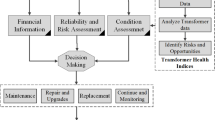Problems of applying-machine learning algorithms to design intelligent relay protection are discussed. The disadvantages of the classical case-based approach to training machine-learning models are highlighted. The task of active learning using a simulation model of an object to synthesize the most informative cases is formulated. A geometric interpretation of the classification model is used to design classifiers. The convergence of the learning process in this approach is considered. The dependence of efficiency on the parameters of the basic classification algorithm is analyzed. A selective classifier of operating modes of a transmission line is trained and analyzed.
Similar content being viewed by others
References
H. Singh, M. S. Sachdev, and T. S. Sidhu, “Design, implementation and testing of an artificial neural network based fault direction discriminator for protecting transmission lines,” IEEE Trans. Power Delivery, 10(2), 697 – 706 (1995).
A. L. Kulikov, D. I. Bezdushnyi, M. V. Sharygin, and V. Yu. Osokin, “Analysis of application of the support-vector method for multidimensional relay protection,” Izv. RAN Énergetika, No. 2, 123 – 132 (2020). https://doi.org/10.31857/S0002331020020065.
C. Liua, Z. H. Rathera, Z. Chena, and C. L. Bak, “An overview of decision tree applied to power systems,” Int. J. Smart Grid and Clean Energy, 2(3), 413 – 419 (2013).
H. Yang, X. Liu, D. Zhang, T. Chen, C. Li, and W. Huang, “Machine learning for power system protection and control,” The Electricity J., 34(1) (2021). https://doi.org/10.1016/j.tej.2020.106881
A. L. Kulikov and M. V. Sharygin, “Use of statistical criteria for recognizing the mode of relay protection of power networks,” Élektrotekhnika, No. 2, 58 – 64 (2019).
Yu. Ya. Lyamets, D. V. Kerzhaev, E. S. Nudel’man, and Yu. V. Romanov, “Limiting modes in the relay protection learning technique. Part 1: Boundary conditions and training procedures,” Izv. Vuzov. Élektromekh., 24 – 30 (2009).
V. Vapnik, The Nature of Statistical Learning Theory, Springer, New York (2000).
Yu. A. Dementiy, “Active learning of a classifier qualifier of operating modes of an object using a simulation model,” in: Proc. 3rd Int. Sci.-Tech. Conf. of Young Specialists of the RELAVÉKSPO-2021 Forum on Current Trends in the Development of Digital Relay Protection and Automation Systems [in Russian], Izd. Chuvash. Univ., Cheboksary (2021), pp. 157 – 162.
R. Fan, K. Chang, C. Hsieh, X. Wang, and C. Lin, “LIBLINEAR: A Library for Large Linear Classification,” J. Machine Learning Res., 9, 1871 – 1874 (2008).
M. V. Martynov, Study and Development of Trainable Modules for Microprocessor Protections of Power Transmission Lines. Candidate’s Thesis [in Russian], Cheboksary (2014).
J. A. Orenstein, “Multidimensional tries used for associative searching,” Inform. Proc. Lett., 14(4), 150 – 157 (1982).
M. F. Balcan and R. Urner, Active Learning-Modern Learning Theory, Encyclopedia of Algorithms, Springer, New York (2016). https://doi.org/10.1007/978-1-4939-2864-4769
Yu. A. Dementiy and K. P. Nikolaev, “Deterministic method of constructing an image of a simulation model of an object,” in: Proc. 3rd Int. Sci.-Tech. Conf. of Young Specialists of the RELAVÉKSPO-2021 Forum on Current Trends in the Development of Digital Relay Protection and Automation Systems [in Russian], Izd. Chuvash. Univ., Cheboksary (2021), pp. 168 – 172.
J. C. Spall, Introduction to Stochastic Search and Optimization, John Wiley & Sons (2003).
I. Olkin and H. Rubin, “Multivariate beta distributions and independence properties of the Wishart distribution,” The Annals of Math. Stat., 35(1), 261 – 269 (1964).
B. Scolkopf, J. C. Platt, J. Shawe-Taylor, A. J. Smola, and R. C.Williamson, “Estimating the support of a high-dimensional distribution,” Neural Comput., 13(7), 1443 – 1471 (2001).
Author information
Authors and Affiliations
Corresponding author
Additional information
Translated from Élektricheskie Stantsii, No. 9, September 2021, pp. 45 – 53. DOI: https://doi.org/10.34831/EP.2021.18.52.008
Rights and permissions
Springer Nature or its licensor holds exclusive rights to this article under a publishing agreement with the author(s) or other rightsholder(s); author self-archiving of the accepted manuscript version of this article is solely governed by the terms of such publishing agreement and applicable law.
About this article
Cite this article
Dementiy, Y.A. Active Learning of Intelligent Relay Protection: Opposing Modes. Power Technol Eng 55, 939–946 (2022). https://doi.org/10.1007/s10749-022-01456-x
Published:
Issue Date:
DOI: https://doi.org/10.1007/s10749-022-01456-x




